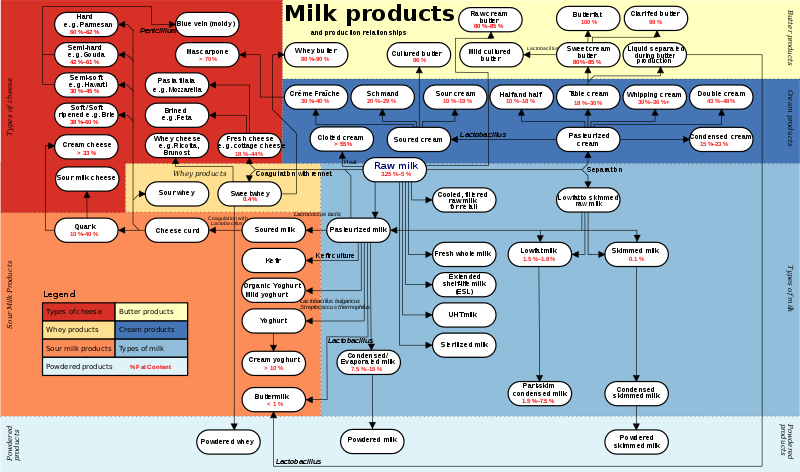Origins & Information - (A-Z) Creams
You have a recipe that you want to use, and it lists light whipping cream. You have half-and-half in your refrigerator and wonder if you can use it as a substitute. Can you? There are so many creams out on the market and various uses for each one that it can be hard to get it all straight. You don't want to mess up your recipe but you also don't want to have to stock your refrigerator with six different creams. I pondered this question a while ago when I made a dish that required whipping cream when I only had half-and-half. So here's the dish:
First off, what is cream? It's the butterfat layer that rises to the top of milk before homogenization. Though the butterfat naturally rises to the top of milk, this process is sped up commercially through the use of centrifuges. This is skimmed off and used to produce all the different creams you see in stores - the amount of butterfat (by percentage or range as designated by the Code of Federal Regulations, Title 21, Part 131) determines what kind of cream it is, how well it will whip, and how stable it will be. The higher the fat, the better the taste (generally) and the richer the texture; obviously it will also be thicker! Fun fact: the yellow-white color that we call "cream" comes from the yellowish cream produced by cows who graze on natural pasture (the plants' pigments) though cream can also be white and has been produced by those fed on grain.
Facts about cream
- Cream is labeled pasteurized or ultra-pasteurized. The former will taste better, whip fluffier, and hold up longer. The latter is harder to work with for whipping as it has been overheated.
- Leftover cream near expiration can be frozen. Refrigerate to thaw and mix together in case of separation.
- Cream with more fat will not curdle in soups.
- To whip cream yourself, make sure the cream, bowl, and all utensils are cold. Beat at medium speed until it thickens (for soft peaks, cream will droop from beater end but for stiff peaks, cream will hold).
- Creams will vary in availability and type based on country.
- If your recipe calls for a cream that you don't have, the safer bet is to go higher in fat content than lower. If you are trying to cut calories, you should use the cream just below the one needed in fat content.
Types of cream
- Half-and-half (10.5-18% fat, ~12%): commonly used as coffee creamer or in other drinks, 1/2 milk and 1/2 cream, can replace whipping cream in cooking, does not whip
- Sour cream (12-16% fat): different from the other creams listed as it has had bacterial cultures added to it that produces lactic acid, used in baking with baking soda to replace baking powder, used in savory dishes, does not whip
- Light/coffee/table/single cream (18-30% fat, ~20%): similar to half-and-half, does not thicken when beaten, cream with 30% fat will whip but not be stable, used in both sweet & savory dishes
- Crème fraîche (28% fat): slightly soured with bacterial cultures, thick and matured with nutty taste, expensive to purchase, used as a dessert topping, used in sauces and soups
- Light whipping/whipping cream (30% fat): thickens when whipped but not as well as heavy whipping cream, almost all are ultra-pasteurized, used for toppings and fillings, not good for piping
- Whipped cream (>30% fat): made by mixing air into cream with >30% fat (nitrous oxide may also be used), used for topping
- Heavy/heavy whipping cream (36-38% fat): whips denser than whipping cream and doubles in volume, holds shape and whips well, used for fillings and decorations of pastries, used in savory dishes
- Double cream (48% fat): whips easiest and thickest (often over whipped so it is too thick), used for puddings and desserts (particularly pies), used in sauces, good for piping
- Clotted/Devon/Devonshire cream (55-60% fat): thick and rich, made by heating unpasteurized milk until cream sits on top (cooked flavor), not common in the U.S., used as is with scones and fruit
I also made a chart that you can save for yourself for reference! Below is an interesting diagram available on Wikipedia of different milk products - check it out!
This post is part of an A-Z series I am running for my blog category "Origins and Information" while I am in Vietnam with my family for July. Many of the posts in the series answer questions that were posed by friends/readers. If y'all enjoy the series, I will gladly run another in the future!
Tags:
A-Z
Origins and Information














0 comments